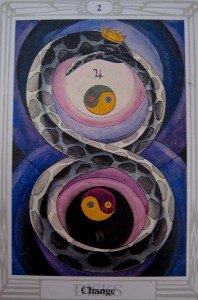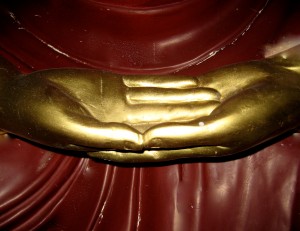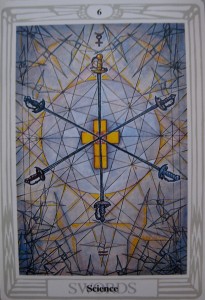We’ll be posting Chuck’s blog later today rather than Jan’s usual Wednesday blog, so look for her blog to appear on Friday this week instead.
Monthly Archives: January 2013
Chuck’s Place: Redeploying Intent

Every morning as we awaken, if we pause for a moment, we can observe the process of our transition from one world to another. In that moment we stand between worlds, between the world of dreams—of higher vibrational energy body states—and the world of ordinary reality, the one that our dense physical energy body wakes up in and prepares to live the day in.
We might also notice how we call that waking world to us, what the Shamans of Ancient Mexico refer to as calling the intent of life in the human form. That intent is stored in the habits and beliefs we enact as we enter the day. As soon as we awaken, our internal dialogue awakens too and begins its spin, reminding us of who we are in our human form.
“Oh yes,” it might tell us, “I am a being who is afraid of people in authority.” Or it might suggest, “I am a being who is afraid to lose my job,” or “I am a being who doesn’t feel attractive,” or “I am a being who must clothe over my flaws,” or “I am a being with physical ailments that I must create tension around to feel present in my body.”
It’s possible that our internal dialogue may produce the following as well, “I am a being who is tired in the morning,” or “I am a being who must stay anxious in order to remain focused,” or “I am a being who must rush around and worry,” or “I am a being who is sad and lonely.”
Once we’ve established our link with the intent of who we are in human form, our internal dialogue is geared up to remind us incessantly throughout the day with its repetitive mental thoughts of who we are and who we are not. The Shamans of Ancient Mexico say that every ounce of energy we have is given over to upholding the intent of who we are and how we define this world, so much so that all the possibility of perceiving or conceiving of life beyond the structure of that intent is completely screened out. Our intent to uphold who we are and what this world is comprised of is completely sealed off by the gatekeeper of the mind, constantly chattering away, repeating the same old phrases.

We see an exact replica of this internal dialogue in our digital age. The speed and constancy of our hunger for nonstop digital input into our central nervous system to define and know our world is matched only by the incessant internal dialogue inside our minds that nonstop feeds us our stories of who we are and what our world is made up of. We’ve become terrified of a pause, a gap, a movie that streams too slowly, calmness, aloneness, a quiet moment with no input, a gap that just for a moment throws us a glimpse of another world.
We constantly long for change, yet we grasp at the familiar. The truth is though that our internal dialogue keeps us stuck, as the world we currently uphold seduces us to believe that faster delivery of information or quicker connection is all we need to experience our unrealized potential. But, in actual fact, this is our world swinging us to the Rajas pole, our world of ordinary reality on a manic speed trip. Inevitably, the great revving up then alternates and swings us in the opposite direction and we crash, as we ride the pendulum that Jan wrote about in her blog this week. But the truth is that even this bi-polar swing remains safely locked in the boundaries of ordinary reality. How could it be otherwise when what we hear in our heads are the same mantras repeated over and over again.
As I have often written, don Juan Matus states that to truly travel in the unknown we must be extremely sober. Sobriety bears the tension of the pendulum swings of this world. In sobriety we offer ourselves the opportunity to avoid the lure of the extremes. The seduction of the extremes is transcendence—the opportunity to achieve a spiritual experience—a going beyond life in the mundane, with the boring repetition of our stuck patterns. It’s a trap, however, and that trap is called addiction—the use of excess to offer the opportunity to glimpse beyond the mundane, beyond ordinary reality. Such excess may result in death through the recklessness of daring or the suicide of depression.
The Shamans of Ancient Mexico suggest a real alternative to breaking the patterns of the mundane, offering an opportunity to truly discover and live our unknown potential: Redeploying Intent.

Just as we semiconsciously and automatically call the intent of this world to us each day upon awakening and monotonously repeat it to ourselves throughout the day, we can consciously call a new intent and engage in repetitive practices to fully realize and reenforce that new intent. That new intent might be to dream lucidly, to peer beyond the known self into the un-recapitulated self, to heal the body, to experience fulfillment, to unite with the divine—the possibilities are endless.
All that is really required is that we soberly state our intent in words, that we repeat it often, letting it become our new personal mantra, a new personal prayer. In stating our intent incessantly, mindfully shifting our attention away from the ever-present internal dialogue that has so far controlled us, we offer ourselves the opportunity for real breakthrough and lasting change leading to fully realizing our greater potential.
Each one of us can make room for the realization of our personal intent. To do so, we must take back our energy that is currently entwined in the habits and beliefs of our incessant dialogue, ridding ourselves of the gatekeeper of the mind by disrupting our familiar habits, routines, and mantras. The Shamans of Ancient Mexico never look in the mirror to break themselves of attaching to self-importance. Perhaps that’s something to give up, only using a blurry mirror to groom or shave.
Take an energy inventory. How do you personally spend your time each day? What is your incessant dialogue? What activities steal your energy? Cut out the unnecessary, particularly activities connected to upholding self-importance, i.e., constantly checking Facebook or some other digital drain, or that mirror. Enjoy the pauses afforded as energy accrues, recouped from habit.

Engage instead in physical activities and practices, such as simply walking, yoga, meditation, martial arts, dance, tensegrity, playing an instrument, or something else that shifts attention from the internal dialogue to bodily awareness. You will be supported by the ancient intent implied in many of these practices, as well as the creative that always seeks engagement.
Finally, I suggest embracing the sober not-doing of knowing that your intent will be realized. Have no attachment to the outcome of the realization of your intent, simply intend it, with the clear certainly that it will be realized. And then, as Carlos Castaneda was so fond of saying: See what happens!
Intento!
Chuck
A Day in a Life: The Swing Of The Pendulum

I ponder the pendulum, how once set in motion it swings back and forth, around and around, sometimes pulled inward, sometimes pushed outward, and how life itself is like this pendulum.
Michio Kushi the founder of the East West Foundation and a proponent of the macrobiotic lifestyle says: “Macrobiotics focuses on the dynamics of yin and yang in daily life. Yin is the name given to energy or movement that has a centrifugal, or outward, direction, and results in expansion. Thus diffusion, dispersion, expansion, and separation are all yin tendencies. Yang, on the other hand, denotes energy or movement that has a centripetal, or inward, direction, and results in contraction. Fusion, gathering, contraction, and organization are yang tendencies.” *
I set my intent a long time ago to study the Middle Way, the Tao, seeking greater harmony with my environment. For the past several years I’ve been engaging in adopting a macrobiotic lifestyle, for its principles of yin and yang and harmony with nature are exceedingly appealing to me. Having at times throughout my life been vegetarian and having always sought diet-related balance, the macrobiotic theory is both familiar and timely for me personally, but I find its principles especially poignant as we face the situation of our planet. And so, when I read Chuck’s last blog regarding Tamas, Sattva, and Rajas, it all made perfect sense to me: the pendulum, the Middle Way, macrobiotics, life itself.
Kushi says: “Everything in the universe is constantly changing. Each day we experience the result of this unceasing motion as night changes into day, activity changes into rest, youth into old age, life into death and death into rebirth. An understanding of the changes that govern our lives and the natural environment, and a recognition of the interrelationship between opposite yet complementary tendencies within these changes, helps us to achieve harmony in our bodies and minds.”
And so, for the past few days, as I ponder the image of the pendulum, the yin and yang in all of nature, the Vedic principles of Tamas, Sattva, and Rajas, a song runs repeatedly through my head. Part of it goes like this: “Oh would you like to swing on a star, carry moonbeams home in a jar, and be better off than you are, or would you rather be a pig!”
I first heard this song as a child when watching a Little Lulu cartoon. It was one of my favorite cartoons, and yes, I always preferred the part about swinging on a star, but I could not get away from the image of the pig rolling in the mud. The shift in the melody from a high note to a low note as the cartoon shifted from Little Lulu swinging on a star to the pig is significant.

The synchronicity of these two images, the pendulum and the song about swinging on a star, arriving together do not escape my notice. Here we have the same image, the realities of life that we are all presented with every day of our lives, as we swing between the opposites. It’s impossible to escape the yin and yang of life, the Tamas and the Rajas, for we would not be in harmony with nature if we did not flow with what comes to us. Kushi says: “The forces of yin and yang are the most basic and primary, and are found throughout creation. All movement, formation, change, and interaction can be understood in terms of a basic yin and yang equation.”
We could not survive if we did not allow ourselves the experience of all of nature. Life itself is impossible without air, but too little air leaves us dull and unhealthy, while too much breath leaves us lightheaded. Sometimes we need a lot of breath to get through a situation, so on occasion excess of breath is necessary. For instance, a runner needs to breathe more vigorously when hitting a challenging terrain and this is good, but once the challenge is conquered a return to a calmer though still slightly heavier breathing pattern is appropriate when running. In our every day walking life, however, more normal breathing is appropriate. We all need sleep, but too little sleep leaves us dull and listless. On the other hand, if we were to sleep all the time we’d end up equally compromised, ending up as stagnant and inert beings with little incentive to return to life. Sometimes, however, more sleep is appropriate, just as sometimes more breath is appropriate. A return to normalcy, to the Middle Way, however, once the occasion for excess has passed, is necessary.
I see life as a swinging pendulum, energy in motion, and I swing with it, going where it takes me, making choices as I go, constantly being aware of choosing appropriately, considering my behaviors, my food choices, what and whom to engage, and how best to use my energy in order to remain in harmony within myself, nature, and the world without. This is riding the pendulum, deciding what feels energetically right for me, the person I am, in this body I reside in on a daily basis. Sometimes I go into excess and when I do I know that there will be an equivalent balance in the opposite direction. If I eat too much carrot cake, for instance, I might feel the loss of energy associated with the drop in blood sugar as the effects of the sugar wears off. This is the principle of yin and yang in action, the swinging of the pendulum, and as Kushi says: “In everything there is a front and a back.”
I try to keep these things in mind as I go about my daily life, noticing how my own pendulum swings, how it reacts to my environment, to my inner desires, how I may be momentarily drawn in one direction, but if I wait a little I notice how I swing away from that desire rather quickly. Sometimes a pause is all it takes, that split second before the turn of the pendulum, a slight hesitation before it swings in the opposite direction. I know that as it swings I will have new things to encounter, new desires might arise or not. Calmness and balance might ensue, agitation or worry might ride the pendulum with me for a while too, but eventually I get to the place of knowing that everything I encounter is okay. It’s all part of nature, of yin and yang, Tamas and Rajas; accepting what comes to greet me is all part of the Middle Way, being in balance, in Sattva.
The intent of my personal spiritual practice has long been in learning how to flow, how to allow for the swings of the pendulum without greater attachment. I have learned that though it swings this way now, it will swing in a new direction soon enough. And so, I am in harmony as I swing, though always seeking deeper meaning, deeper connection to my natural state of being, to my environment, to the people in my relationships, to my inner work. This is life. It is enough.
Riding the pendulum,
Jan
* Quotes are from The Macrobiotic Way by Michio Kushi.
And here is Little Lulu swinging on a star: Youtube video of 1944 cartoon.



